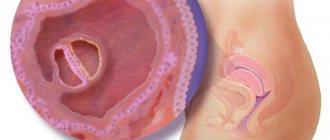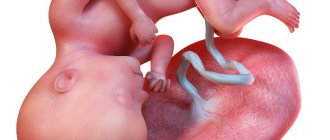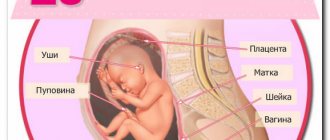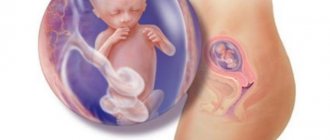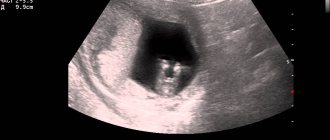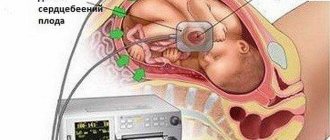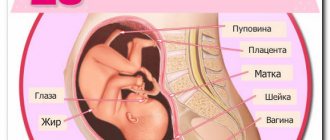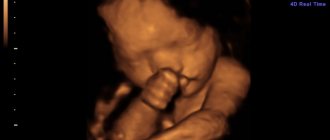- Childbirth
- Ultrasound
- Stomach
- Fetus
- Weight
- Feel
- Pain
- Discharge
- Sex
Childbirth
At week 38, there comes, one might say, a “turning point”: now mommy can give birth at any minute. Moreover, it is more likely that childbirth at the 38th week of pregnancy ends in the birth of girls, while boys like to “sit” longer in their mother’s tummy, waiting for the allotted 40th week.
And yet, childbirth at 38 weeks of pregnancy is highly likely, especially for women giving birth repeatedly. Thus, only about 5% of those pregnant with their second child “finish” all 40 weeks. Childbirth at the 38th week of pregnancy occurs according to the standard pattern, in three periods. The first stage involves contractions, during which the cervix thins and stretches. In the second stage, efforts are required - for the baby to come out and be born. The third, concluding period is the birth of the placenta, or placenta, after which the woman becomes a happy mother.
Ultrasound
An ultrasound at the 38th week of pregnancy is usually no longer performed - three planned ultrasound examinations are already a thing of the past, and the woman is preparing to become a mother with a calm soul. An ultrasound at 38 weeks of pregnancy may be needed only for some special indications, for example, to accurately exclude entanglement in the umbilical cord, to confirm the correct location of the baby in the uterus.
What's happening?
At 38 weeks of pregnancy, your baby is no longer growing as rapidly as before - after all, all his organs and systems are fully formed, and he is absolutely ready for independent life.
At this time, the baby gains no more than thirty grams per day, and accordingly, the mother should not gain much weight. The main reason for weight gain during this period is swelling. Try to eat right, do not eat too sweet and fatty foods, limit yourself to liquids - this way the appearance of edema can be, if not prevented, then significantly reduced.
Quite serious signs that should be immediately treated at the maternity hospital are headache, diarrhea, dizziness, combined with severe swelling and high blood pressure. This is preeclampsia, which is extremely dangerous for both mother and baby. If you notice several of these symptoms, call an ambulance and immediately go to the maternity hospital. If you receive timely assistance, you and your baby will not be in any danger.
Mother. Sensations and changes in the body, preparing for childbirth
Condition of the mother at the 38th week of pregnancy
At the 38th week, most women begin to feel better than in previous weeks. Several factors contribute to this:
- the stomach begins to sink lower, giving the stomach and lungs more freedom. It becomes easier to breathe and eat. These changes are not observed in all women; in some, uterine prolapse may begin later, and in some cases before the birth itself; less often, the uterus does not change its location at all before the baby is born;
- from the 38th week the main period of gestation is completed, the expectant mother is less worried about maintaining the pregnancy, because if the baby is born, he will be capable of normal life activities;
- appetite decreases. By eating less and not feeling the constant desire to chew, the parent is less likely to experience discomfort from the gastrointestinal tract, although nausea and stool upset may appear immediately before childbirth;
- the amount of energy increases. The desire to prepare everything for the arrival of the baby comes with redoubled force, the expectant mother feels an emotional uplift and a surge of strength. But against the backdrop of a large belly and the difficulties associated with it, fatigue quickly sets in and fatigue sets in.
At the 38th week, the female body still experiences discomfort from the enlarged uterus, which contains a fairly large baby. Periodically, unpleasant sensations are felt:
- in back. The spine is under severe stress, responding with pain after a long walk or work;
- in the legs. Cramps and pain may appear or continue to cause discomfort. Quite often, it is at this time that varicose veins appear. It is recommended to carefully monitor the condition of your legs, consult a gynecologist in a timely manner about the need to wear compression garments or use medications and cosmetics;
- lower abdomen. Unpleasant sensations can be caused by gradual separation of the bones, pressure on the bladder and intestines. If a pregnant woman experiences periodic pain in this area, it is worth contacting a gynecologist for advice. When the abdominal prolapse begins, the pressure on the bladder and pelvis increases. The number of trips to the toilet increases, and there is a feeling of a constant desire to pee. This is normal if urination is not accompanied by pain or pain. In this case, you need to contact a gynecologist, having first passed a urine test;
- in the chest. Those expectant mothers whose belly has not begun to descend continue to experience discomfort in the lungs, stomach, and diaphragm. Also, in some cases, discomfort is caused by the preparation of the breast for lactation: it swells, becomes covered with a network of blood vessels, and colostrum is released.
At the 38th week, the expectant mother increasingly thinks about the issue of impending birth. Some women are worried that they will not be able to understand in a timely manner that the process has begun, others worry that it will be too painful, and still others think about possible complications and difficulties.
If there is insufficient awareness and preparation for what is coming, a pregnant woman may experience severe stress, which will not benefit either the mother or the fetus. It is recommended that if you have questions related to the approaching birth, you should remain calm and positive, and dispel fears with knowledge: consult a gynecologist, read the information below.
Harbingers of childbirth
Childbirth is a complex natural process that requires a lot of strength from the female body. In order for it to proceed correctly, nature has provided for a number of changes that occur in the female body shortly before day X. In some cases, changes begin in advance, 1-2 weeks, in others - immediately before childbirth: 1-2 days.
It is quite difficult to guess when a particular woman will start giving birth, judging by the harbingers, so the expectant mother should not panic when she discovers this or that sign; it is better to carefully consider the procedure.
At the 38th week, a woman may notice the appearance of precursors of labor:
- prolapse of the abdomen. In preparation for childbirth, the female body adjusts, the uterus moves lower into the pelvic area, reducing pressure on the lungs and stomach, but increasing pressure on the pelvic organs;
- increased frequency of urination. The uterus puts more pressure on the bladder, increasing discomfort and making trips to the toilet more frequent;
- increased frequency of training contractions . Non-painful contractions become more frequent at week 38 and may cause inconvenience. If they do not occur with the same frequency and do not cause pain, this is a normal phenomenon, training before childbirth;
- decreased appetite. During the birth of a new life, it is important for the body not to be distracted by extraneous processes. Hormonal levels reduce a woman’s desire to eat so that the digestive system is not overloaded with work, taking a lot of energy;
- a sharp decrease in weight up to 1.5 kg. Excess fluid leaves the body, the amount of food intake decreases - this leads to a decrease in body weight;
- increased bowel movements, diarrhea. Usually these precursors appear immediately before childbirth, 1-2 days. If a woman notices the appearance of causeless stool disorder, it is recommended to strengthen control over her well-being in the coming days;
- “Nesting syndrome” is a popular name for the behavior of women before childbirth. Many expectant mothers have a strong desire to clean up the whole house in order to prepare it for the baby;
- shortening of the cervix. This harbinger can only be seen by a gynecologist or obstetrician during an examination. For the fetus to be born, the cervix needs to shorten and open. During the first birth, most often, there is a slow shortening at first, followed by an opening. The second and subsequent births are characterized by the simultaneous occurrence of both processes.
These signs are called precursors of childbirth; depending on the characteristics of a particular woman, they can appear both 2 weeks before day X and immediately at the beginning of the birth process. Any option is considered normal.
Childbirth, when to go to the hospital
How to understand that contractions have begun
Childbirth at the 38th week occurs quite often, especially in multiparous women. The expectant mother should understand what signs should help her get to the emergency room of the maternity hospital as quickly as possible:
- constant abdominal pain that does not go away at rest, gradually intensifying;
- increased training contractions, the appearance of pain. The abdomen turns to stone at regular intervals;
- the baby is quiet, does not knock at rest or on the left side for 60 minutes;
- aching, persistent pain in the back (lower part). The pain can be localized to one point or spread to the entire lower body. If the discomfort does not subside while lying down, you need to go to the maternity hospital;
- a feeling of pressure in the thighs with pain, aching pain in the pubis. It may seem to a woman that the pelvic bones are actively moving in different directions;
- vomiting, intestinal cramps, diarrhea or frequent bowel movements along with other signs of labor are a signal to immediately go to the maternity hospital;
- rupture of amniotic fluid. A woman may feel a pop in the area of the uterus, after which a noticeable amount of fluid flows out of the vagina. From this moment on, the woman should not perform any hygiene procedures and immediately call an ambulance or go to the maternity hospital by car, while trying not to sit, but to lie down.
Having noted the appearance of one or more signs of labor, the best decision would be to go to the maternity hospital, where an obstetrician-gynecologist will examine you in the emergency room and refer you to the maternity ward or pregnancy pathology department to identify the cause of what is happening.
What is the difference between training contractions and real ones?
Quite often, at the 38th week, primiparous women are worried about the question: “How to distinguish training contractions from real ones?” In some cases, training movements of the uterus bring a woman not only discomfort, but also pain, so a pregnant woman may be afraid to miss an important time. We would like to reassure you that it is almost impossible to confuse real contractions and training ones. There are several signs that will help you calm down and clearly understand what exactly is happening:
- periodicity. Training contractions do not have a specific rhythm of occurrence; approximately the same period of time passes between real contractions, which is constantly decreasing. When giving birth for the first time, you can go to the maternity hospital when the interval between contractions reaches 15 minutes with the duration of abdominal tone up to 2 minutes; for repeated births (especially after a short period of time after the previous birth: up to 5 years), it is worth going from the very beginning of labor;
- abdominal tension. During training contractions, only part of the abdomen tenses: top, bottom, during childbirth - the entire surface of the abdomen becomes stone, this is accompanied by painful sensations;
- the ability to influence unpleasant sensations. During a training contraction, you can reduce its intensity: rest, drink water, take a walk; during childbirth, the intensity of the pain increases, the duration of the contraction increases and cannot be manipulated to reduce sensations, the woman should try to breathe through the contraction correctly, but the pain will not go away completely.
What to do if labor begins at 38 weeks
If a woman realizes that labor has begun, she needs to call an ambulance or go to the maternity hospital by car, taking the necessary things with her. First of all, she must have a complete set of documents in her hands:
- maternity passport (+copy);
- compulsory medical insurance/voluntary medical insurance policy (+ copy);
- exchange card issued in hand at the antenatal clinic;
- insurance certificate of the state pension fund;
- birth certificate (if already received in consultation);
- referral to the maternity hospital (if any);
- agreement with the maternity hospital or doctor (if any).
With your documents, take a bag with permitted items to the delivery room. Please note that different maternity hospitals may have their own prohibitions on personal belongings of women in labor. It is advisable to collect a package with things for childbirth in advance, guided by the rules of the selected maternity hospital.
If a woman’s water has not broken, the intensity of contractions is low: about 4-5 per hour, then the pubic area can be shaved. At 38 weeks, it can be very difficult to do this on your own, so it’s a good idea to ask your loved ones for help.
In maternity hospitals there is no single decision on this issue; in some, shaving is not considered mandatory, according to new research; in others, they are guided by the need for hair removal during surgical interventions.
It is advisable to choose clothes for a trip to the maternity hospital according to the principle of “what is easier to take off and fold.” In the emergency room, the woman will be completely undressed, so as not to waste time changing clothes and folding clothes, it is better to take care of a small amount in advance. It’s good if someone close to you comes to the maternity hospital with the woman in labor, who can take unnecessary things home.
Fetus at 38 weeks of gestation and its development
Your baby is already fully formed: the lungs are ready to breathe air, the heart is able to supply the entire body with blood, the kidneys and intestines regularly remove harmful substances from the body, and the brain is mature enough for the baby to be away from the mother.
The child loses lanugo and vernix and becomes pretty - after all, he has already accumulated sufficient fat reserves, so the baby’s body and face acquire a charming baby plumpness. Marigolds continue to grow - some babies are born with a long manicure, which can scratch themselves and their mother.
During this period, the child no longer grows as actively as before, and its size does not allow too active movement in the uterus, so most of the time the baby rests, preparing for the upcoming birth.
Decoding the results
The research data is transferred to a form that the woman will provide to her gynecologist. It notes the expected height and weight of the fetus, its gender, condition and amount of amniotic fluid.
The location of the placenta and its degree of maturity are also indicated. The doctor will examine the placenta; its structure is important to determine the degree of functionality. At 38 weeks, the placenta ages, providing the fetus with less nutrients and oxygen. The degree of her maturity is now mainly second or third, and her weight ranges from 450 to 600 g. If the baby’s place does not perform its functions well, measures will be taken for urgent delivery.
What to pay attention to
Since the baby is already quite large, the doctor examines body parts and organs separately from different angles, making all the necessary measurements and calculations. Pay attention to the fetal heart rate, the degree of its activity, and its size in accordance with the norm for fetometry.
What does a child look like?
The baby's facial features are already formed, plump cheeks appear due to the increase in subcutaneous fat. The child's ears become harder and sharper nails grow. The fetus descends lower into the pelvis, in most cases - head down, taking the correct presentation. If the baby is sitting “on his butt,” this may be an indication for a cesarean section, since natural childbirth will be very difficult.
Child behavior
If you perform a 3D ultrasound, you can see the face of your unborn child. He winces, grimaces, sucks his thumb like a newborn baby, and even plays with the umbilical cord.
At this stage, there is little space in the uterus, the fetus moves less often and no longer tumbles as before, taking the head-down position before birth. The head is lowered into the mother's pelvis. He has already formed periods of sleep and wakefulness, so the mother may feel that the child is sleeping longer than usual, or is not as active, and become worried.
Fetometry fetal size at 38 weeks
Indicators of normal development in this gestational age (child size on ultrasound at 38 weeks) are as follows:
- height from head to feet – 45-52 cm, weight – about 3000 g;
- BPR is 850-100 mm;
- fronto-occipital size – from 108 to 128 mm;
- OG (fetal head circumference) is 309-360 mm;
- Coolant (abdominal circumference) is 304-368 mm.
Normal sizes of long bones
The sonologist must also determine the length of the bones of the limbs, which at this intrauterine age are:
- femoral - from 6.8 to 7.8 cm;
- shins - from 6.6 to 6.8 cm;
- shoulder – from 6 to 7 cm;
- forearm – from 5.2 to 6 cm.
Special situations if ultrasound results do not correspond to the gestational age
In some cases, there is a discrepancy between the sizes that should be when the pregnancy is 38 weeks old according to ultrasound. For example, bone length, height and weight of the fetus lag behind normal values. If it is developed proportionally, then, most likely, hereditary factors influenced it, and the child will be small.
If a disproportion in size is established, for example, long bones correspond to fetometric standards, but height and weight lag behind, then we can talk about IUGR - intrauterine growth retardation.
Perhaps, based on additional examinations (Doppler, CTG) and tests, the doctor will decide to induce labor. At this stage, the baby is considered mature and its viability is not a concern. In the womb, if hypoxia, pathology of blood flow or failure of the postoperative scar is confirmed, his health will be at risk, therefore, further tactics for managing pregnancy and delivery should be developed by a gynecologist.
Belly at 38 weeks pregnant
At the 38th week of pregnancy, the belly usually already drops (although in some pregnant women it does not drop until the very birth), and the expectant mother becomes much easier. The uterus does not put so much pressure on the stomach, which is why heartburn and nausea go away and appetite returns. The lowering of the abdomen occurs due to the fact that the baby’s head begins to descend into the pelvis before birth.
Despite the improvement in well-being, you should not go too heavy on food - the weight gain by the end of the 38th week of pregnancy should be from 8 to 15 kg (the greater the initial weight, the greater the gain). On the contrary, you should completely exclude smoked foods, pickles, and sweets from the menu, and you should more often consume fresh vegetables and fruits, dairy products, and low-fat varieties of fish and meat. By following the right diet, you will likely be able to minimize swelling and avoid gaining excess weight before giving birth. Each kilogram gained above the norm significantly complicates the birth process for both the mother and her baby.
Fetal growth and development
This week is considered a week of improving all systems and organs of the baby and the preparatory period for his birth. Its parameters will hardly change during these seven days, which is due to the aging of the placenta and a decrease in the amount of nutrients passing through it to the fetus. Such poor nutrition affects the cessation of weight gain and growth. Changes, if there are any, will be by fractions of a cm and several tens of grams. Everything that passes through the placenta is used to ensure the baby’s vital functions and to maintain the heartbeat, which ranges from 120 to 160 beats/min.
The motor activity of the fetus is somewhat reduced due to the tightness of the surrounding space in the uterus. At the same time, the limbs move less chaotically and make at least 10 noticeable shocks per day.
He has well-developed sucking and grasping reflexes. Pulmonary surfactant has already been produced and will provide him with his first breath after birth. Meconium has formed in the intestines from the processing of amniotic fluid - feces, the liver and pancreas are at the final stage of formation.
In addition to internal changes, week 38 is characterized by external changes. The baby becomes the way he is born and the way his parents see him.
- Hair appeared on the head (though not for everyone). It has smooth and pink skin, it is almost not covered with primordial down.
- The lubricant, called vernix, remains only in the skin folds.
- His nails have grown higher than the pads of his fingers, and he can scratch himself with them when he moves his hands.
- In boys, the testicles have descended into the scrotum.
In case of multiple pregnancy, the 38th week is considered the deadline; pregnant women with twins and triplets are often allowed to conceive even at 36-37 weeks. If you are having a girl, she will most likely be born this week.
At week 38, the fetus should be presented cephalically. That is, head down, while it should be tightly located in the woman’s pelvis and close to the outlet. If the fetus is breech, that is, the baby’s butt is positioned towards the exit, this means that childbirth will be more difficult. Special exercises taught to women by obstetricians can save the situation. But this does not always give results; only a fruit with a small mass can turn.
Fetal movements at 38 weeks
By the end of pregnancy, the child significantly gains weight - on average, the weight of babies born at 38 weeks of pregnancy is 3000 - 3500g. This fact does not allow the baby to move in the mother’s tummy as actively as before - after all, he is quite tightly surrounded by the uterus. By the 38th week of pregnancy, the number of movements the baby makes per day is about 10; the rest of the time he rests and gains strength before giving birth. However, you still need to monitor the movements - if it seems to you that you have not felt the baby’s kicks for too long, contact the doctors to make sure that everything is fine with the baby.
Is it necessary to do an ultrasound examination for pregnant women in the last weeks?
Doctors usually do not prescribe such a diagnosis to women at 38 weeks of pregnancy. But for some indications, an ultrasound may still be needed. What are the objectives of the study?
At 38 weeks, a scan is needed for those women in labor who have had a history of caesarean section . If the expectant mother wants to give birth to this baby on her own, without surgical intervention, then the doctor must monitor the condition of the scar on the uterus. After all, there is always a risk of rupture of the reproductive organ. Natural childbirth is permissible only with a healthy scar. This means that the suture area on the uterus should consist primarily of muscle tissue. The thickness of the scar is at least half a centimeter.
If you are at 38 weeks, you may be prescribed an ultrasound to determine the position of the baby. If there is a suspicion that the baby is “sitting on her butt,” then the woman must be sent for an ultrasound. In the future, the issue of natural delivery is decided individually. Doctors are based on the individual characteristics of the patient: pelvic size, health status, previous births, obstetric history, and so on.
Another indication for ultrasound diagnostics is multiple pregnancy. Most twins at this stage, as a rule, are already born. But if this has not happened yet, then the doctor will definitely prescribe a scan. It will help determine the location of the children and exclude the possibility of entanglement in the umbilical cord. If there is a suspicion that the baby is entangled in the umbilical cord, then a study is prescribed for a singleton pregnancy.
Mom's feelings
The last weeks of pregnancy are the most difficult for the mother: her health does not improve, fatigue accumulates, and the pregnant woman begins to suffer from swelling and frequent false contractions. Often, it seems to the expectant mother that her pregnancy lasts forever and will never end. But the proximity of the long-awaited meeting is encouraging!
Swelling is often a real scourge for mothers. They are associated not only with compression of the ureters and bladder, but also with compression of the inferior vena cava, through which blood flows from the legs. When it is pressed by the uterus, the blood stagnates in the veins of the legs, they swell significantly and hurt. To avoid this, try to lie on your left side more often, stand less, and do not sit in one position for a long time. You should absolutely not cross your legs - this will worsen venous congestion in the legs. Limit yourself to liquids. If your legs are very tired, lie down and put them on a pillow or other elevation.
Also, due to compression of the bladder by the descending head of the fetus, the mother begins to visit the toilet even more often. Frequent awakenings due to this are aggravated by anxiety before childbirth, so at 38 weeks of pregnancy, insomnia is also a common companion of pregnant women.
Discharge at 38 weeks of pregnancy should be whitish, with a slightly sour odor. Mucus discharge streaked with blood or pink in color is the release of a mucus plug before childbirth.
Be careful - heavy spotting is a sign of bleeding and requires urgent hospitalization in the maternity hospital! Abundant watery discharge indicates the breaking of water and the onset of labor.
Pain and sensations: what does the expectant mother feel?
The closer the expected date of birth of the child, the more anxiety and questions the expectant mother has. Especially if this is your first pregnancy. What can be considered a normal condition, and what requires urgent medical attention? Let's try to figure it out.
| Bloody discharge | The vaginal mucosa, under the influence of the hormone estrogen, becomes bluish, swollen and filled with blood. Because of this, even a standard gynecological examination at 38 weeks can result in blood “smears” on your underwear. There is no need to be alarmed: if there is very little discharge and it occurred immediately after a visit to the gynecologist, then this symptom does not require treatment; but it is still worth drawing the doctor’s attention to this incident. |
| Discomfort | 1.5-2 weeks before giving birth, a woman’s sensations undergo a number of changes - she encounters heaviness, discomfort and pressure in the sacral area, her stomach pulls and becomes stiff. This is caused by an increase in the elasticity of the ligaments and a change in the position of the pelvic organs. Painkillers during this period will not have the desired effect, so you should not take them to suppress symptoms, especially since side effects at this time can be very unpleasant. |
| Nausea and diarrhea | The cervix ripens under the influence of prostaglandins, and this affects the condition of the organs located “in the neighborhood.” Intestinal perilstatics significantly increase - stool becomes loose, sometimes accompanied by cramping pain. Dilatation of the cervix in some women is often accompanied by nausea and vomiting. But only a specialist can determine whether these symptoms are caused by prenatal changes or infection. |
| Weight loss | More than half of pregnant women lose 1-2 kg by the end of the 38th week. This occurs due to the fact that the production of the hormone progesterone decreases. Swelling goes away, it becomes easier to put on shoes and remove rings. The child is not in any danger from losing his mother’s weight; in any case, he continues to receive all the necessary substances in the quantities his body needs. |
Pain at 38 weeks of pregnancy
Pain during this period is associated with the fact that the body is actively preparing for childbirth: the pelvic bones diverge, ligaments and joints become more pliable, and the cervix gradually begins to open. All these processes cause pain in the lower back and abdomen. In addition, the uterus begins to contract more and more often - for now these are so-called false contractions. If this is your first pregnancy experience, then you can distinguish false contractions from real ones by changing your position or walking around - the false contractions will immediately become weaker. During the 38th week of pregnancy, the stomach feels quite often, it becomes stiff and painful. If contractions become rhythmic and become more frequent, you are most likely in labor and it’s time to go to the maternity hospital.
It is possible and it is not possible
Rules of conduct for a pregnant woman
At the 38th week, a woman should continue to adhere to safety rules in order to avoid undesirable consequences. Childbirth is very close, but it is desirable that it occurs at a time when mother and baby are ready for it. We recommend following some rules:
- listen carefully and follow the gynecologist’s recommendations;
- take tests in a timely manner and carry out prescribed studies;
- no alcohol, nicotine, drugs;
- minimize contact with household and construction chemicals;
- maintain a daily routine and diet;
- monitor body hygiene;
- maintain order in the home;
- ventilate rooms in the house daily;
- do not forget about daily walks in the fresh air;
- avoid contact with sick people and places where there are large concentrations of them during epidemic periods;
- follow the rules for safe movement of a pregnant woman: move smoothly;
- avoid prolonged bent over positions;
- do not move, carry, or hold anything heavy.
- do not work with your arms raised high;
- do not make sudden movements or jerks;
Sex
At the 38th week of pregnancy, intimate life is not prohibited, but most gynecologists agree that it is better to avoid it. The birth process can begin at any moment, and an unexpected movement can trigger it. It should be borne in mind that male sperm contains a substance that helps soften the cervix, which leads to its rapid ripening. In order for childbirth to occur within the time frame intended by nature, it is advisable not to speed up the process.
The 38th week is the home stretch of pregnancy. The fetus is completely ready to be born, and preparations for childbirth are in full swing in the mother’s body. Meeting the baby can happen any day in the next 4 weeks. For everything to go smoothly, it is advisable to follow the recommendations of the gynecologist and our tips posted in the article. A little more, and the most important meeting in every woman’s life will take place.
If you liked the article, please share a link to it
Harbingers of childbirth
The body is already completely ready for childbirth. And are you afraid to miss the moment when this very birth begins? Don’t worry, it’s quite difficult to miss your own birth, and the harbingers of labor will help you prepare for it:
- Your stomach drops and it becomes easier for you to breathe.
- There is slight weight loss.
- Discharge from the genital tract is pinkish, streaked with blood, or copious and watery.
- The uterus is constantly in good shape.
- Periodically, the stomach turns to stone.
- Contractions become more frequent and rhythmic.
The appearance of precursors suggests that labor can begin at any time. Now try not to be alone, all things should be completely assembled and packed, and your husband should be in constant readiness to take you to the maternity hospital.
Contractions
Contractions at 38 weeks of pregnancy can be false, but real contractions can also begin. False contractions are not as painful; usually only the stomach hurts. They usually go away when changing position or moving. Also, between two false contractions, a woman may well fall asleep, which will not happen during real contractions.
Real contractions are quite painful, the stomach and lower back hurt, they do not go away with a change in position. In addition, actual contractions become more frequent and rhythmic over time. As soon as your contractions begin, start counting how long they last and what is the interval between them (this will help the doctor determine the expected time of birth), and also call an ambulance - it’s time to go to the maternity hospital.
The following parameters indicate the onset of labor:
- At least 10 contractions per hour lasting from 30 seconds to a minute.
- Contractions are accompanied by increased discharge.
- Your water suddenly broke in large quantities.
If these signs appear, you should urgently go to a medical facility, although the duration of contractions before birth can be up to 10–12 hours.
Advice for the expectant mother
Very soon your baby will be born. In order for the birth to be as easy and safe as possible, you should learn several very important things during the remaining time of pregnancy:
- listen to your body. Try to feel its changes, and look for the most comfortable positions for relaxation;
- master distraction breathing techniques that help restore strength in the short interval between contractions. In addition, calm, correct breathing during childbirth is the best anesthesia;
- learn the simplest basics of self-massage of the sacrum and lower back;
- savvy yourself in theory. For example, every pregnant woman should know that it makes sense to go to the maternity hospital during contractions that occur at least once every 5-7 minutes and last more than 30 seconds;
- learn the basics of breastfeeding.
Enjoy your last days of pregnancy and get plenty of rest. Don't forget to spend time outdoors, preferably at least an hour before bed. Fill your days with the joy of the upcoming meeting with your baby, positive emotions, and pleasant chores. Let close people be with you at this important stage, ready to provide support and help at the right time.
Research and analysis
In the last weeks of pregnancy, you should visit your gynecologist every week, and you should also take a general urine test weekly to detect serious problems (preeclampsia) in a timely manner.
When visiting a antenatal clinic, the doctor will take measurements of the circumference and abdomen and the height of the uterus, and listen to the fetal heartbeat.
An ultrasound at 38 weeks is done only if there are any problems or malfunctions on the part of the mother or baby.
38 week of second pregnancy
If you already have experience going to the maternity hospital, then your second pregnancy will be easier - after all, you know everything and are ready for anything! The only thing to remember is that the second pregnancy almost always ends in birth at 38–39 weeks of pregnancy. Therefore, by this time everything should be ready for the trip to the maternity hospital - the bags are packed and standing at the doorstep, you and your loved ones have long ago decided who will take you to the maternity hospital, and the baby’s room is ready for his arrival home.
Usually the second birth is easier and faster than the first, although many mothers complain of more severe pain during the second birth. You should know that the cervix opens much faster during the second birth, so lifting weights or traveling on public transport while standing can lead to an unplanned onset of labor - under the weight of the fetal head, the cervix can open very quickly, and the baby can be born in just a couple of tens of minutes. A multiparous mother in late pregnancy should take care of herself so as not to provoke labor ahead of time.
38 weeks pregnant with twins
Of course, it is rare that a twin pregnancy continues until 38–40 weeks of pregnancy, but there are some, and there are quite a few of them. Most often, a multiple pregnancy ends in childbirth before the 37th week of pregnancy - this is due to the heavy load on the body of the mother of twins. If you carried your babies to this term, now they are guaranteed to be born absolutely mature and ready to meet this world!
Twin babies born at 38 weeks of pregnancy are practically no different from other children, except for size - often twin babies have slightly less weight (from 2500g) and height (from 45cm). In terms of development, they are completely consistent with the children who lived alone in their mother’s tummy, and sometimes even ahead of them.
Sex at 38 weeks pregnant
Of course, sex at 38 weeks of pregnancy can be a little more traumatic than at earlier stages - especially if the cervix has already begun to dilate. If you experience a strong sexual desire, you should not deny yourself pleasure, but you need to be careful during sex. Many women are advised by their doctors to have sex to stimulate labor - the surge of hormones during orgasm helps the cervix open better and contractions become more coordinated.
Mother's feelings
- The moment of childbirth is rapidly approaching, and you constantly feel heaviness in your lower abdomen;
- The more your weight becomes, the more difficult it is for you to move;
- The feeling of fatigue that haunted you in the first trimester may return again;
- The height of the uterine fundus from the pubis is 36-38 cm, and the location from the navel is 16-18 cm. The placenta weighs 1-2 kg, and its diameter is 20 cm;
- In the 9th month, you may be very upset by stretch marks or so-called lines; these reddish grooves appear on the stomach and hips, and even on the chest. But don’t be too upset, because after giving birth they will become lighter and, accordingly, not so noticeable. This moment could have been avoided if, from the first months, a special anti-stretch mark product was applied to the skin;
- Many women feel as if their uterus has dropped. This feeling usually occurs in women who have not yet given birth;
- Due to the pressure of the uterus on the bladder, urination may become more frequent;
- The cervix becomes soft, thereby preparing the body for the moment of childbirth.
- Uterine contractions become so noticeable that sometimes you are sure that labor has already begun;
- Colostrum can be a harbinger of an imminent birth. If you begin to notice small spots on your bra, then a joyful event is very soon. Try to wear a bra made only of cotton fabric, with strong straps, this will help preserve the natural beauty of your breasts;
- There is no increase in body weight. Most likely, you will even lose a few pounds before giving birth. This is a sign that the child is already mature and ready to be born. Accordingly, labor will begin within a few weeks.
- On average, during the entire pregnancy, body weight gain should be 10-12 kg. But there are also deviations from this indicator.
- Now your body is actively preparing for the upcoming birth: hormonal levels change, the pelvic bones expand, and the joints become more mobile;
- The belly is so large that it is almost impossible to find a comfortable position. The skin on it is tense and constantly itches;
- Your legs may feel tingling.
What they say on forums about well-being:
Anna:
I’m approaching 38 weeks, but somehow there are no signs (a plug coming out, a drooping abdomen), except pain in the lower back and aches in all the bones... my boy is probably in no hurry to come out.
Olga:
I can't wait to see our doll. At first I was afraid to give birth myself, I even wanted a caesarean, but my friend supported me well, she said that when you are born it doesn’t hurt, it hurts when you have contractions, but you can endure them too, like menstrual patients. So far I'm not afraid at all. I would like to wish everyone an easy and quick birth!
Faith:
I’m 38 weeks, today at the ultrasound they said that our baby turned over and lay down correctly, weight 3400. It was a little hard and scary, even though it was the second time, the first time when I gave birth I went into labor like a fighter, I had so much fun, now it’s somehow not very good... But it’s okay, everything will be fine, the main thing is a positive attitude.
Marina:
We are currently undergoing cosmetic renovations at home, so it is taking a little longer. How can I make it in time? Although if it’s that my parents live on the next street, then we’ll live with them for a while.
Lydia:
And we just returned from the doctor. They told us that the baby's head was already very low, although the uterus had not dropped (37cm). What bothered me was my son’s heartbeat, it was always 148-150 beats, but today it’s 138-142. The doctor didn't say anything.
Questions - answers
I was 38 weeks pregnant and started to worry about frequent urination at night. I used to get up much less often at night. Doesn't this indicate inflammation (cystitis)?
By the 38th week of pregnancy, the fetus begins to lower its head into the small pelvis - the lungs and stomach become much easier, but the baby’s head puts pressure on the bladder much more intensely than before. In this regard, before giving birth, many mothers complain that the frequency of the urge to urinate has become such that they literally cannot leave the toilet. If, during a routine visit to the antenatal clinic, no changes are detected in the urine test, this means that the due date is approaching.
After the 38th week of pregnancy has arrived, you want to sleep almost all the time. At the same time, I often get up to go to the toilet at night, don’t get enough sleep, and then during the day I want to sleep even more. I feel overwhelmed and very tired.
Towards the end of pregnancy, many mothers feel tired and look forward to giving birth. This is normal, especially since bladder problems and anxiety are keeping you from getting enough sleep. However, when visiting a antenatal clinic, it will not hurt to take urine and blood tests, examine blood glucose levels, and measure blood pressure. If after these studies the doctor does not find any pathology in you, there is no reason to worry, but you should try to rest more, walk in the fresh air before going to bed.
Is it true that an orgasm at 38 weeks of pregnancy can trigger labor?
It is believed that sex, and especially orgasm at 38 weeks of pregnancy, can improve the course of labor - with a surge of hormones in a woman’s body during orgasm, the cervix begins to open better, and contractions become more coordinated. There is currently no evidence that regular sex can trigger the onset of labor. Of course, if you do not have careless sex, during which the genital mucosa or amniotic sac may be injured.
Signs of approaching labor
Precursors of labor may appear singly, complexly, or be absent altogether. But even if you notice their onset, this does not mean at all that the process of giving birth to a baby is about to begin. Precursors of childbirth in first-time mothers differ from precursors in women who have already given birth, with more striking manifestations. Preparing the female body for childbirth is a delicate and highly individual matter; it often occurs gradually, and sometimes almost at lightning speed.
Training contractions
Increased contractile activity of the uterus and an increase in its sensitivity lead to the appearance of training contractions (or Braxton-Hicks contractions). They feel painless, occur at irregular intervals and do not lead to dilatation of the cervix. At week 38, such contractions intensify and become more frequent; these harbingers of labor are especially clearly felt in multiparous women. But their difference from real contractions is that training contractions can be “calmed down” in a shower or in a warm bath, as well as by the action of antispasmodics prescribed by an obstetrician.
Removal of the mucus plug
By 38 obstetric weeks, the cervix shortens, which leads to the release of a mucus plug. Doctors call a plug a dense clot of mucus, which during pregnancy was a kind of “barrier” between the membranes of the fertilized egg and the female vaginal flora. Externally, the clot looks like a jelly-like discharge of a transparent color with pinkish veins. The plug may come out in parts over 1-5 days, or come out all at once. If the expectant mother's plug comes off, she may complain that her stomach hurts and her lower abdomen is pulled, as if she was on her period.
Descent of the abdomen
This sign is considered one of the most important external manifestations of the upcoming birth. In the later stages, the baby’s head is pressed against the entrance to the pelvis, while the fundus of the uterus drops several centimeters. The belly at 38 weeks of pregnancy becomes lower, which is quite noticeable to the eye. The feeling of lack of air disappears, the pressure on the diaphragm has decreased, and the woman can finally breathe deeply. But this increases the pressure on the bladder, and therefore the expectant mother has to go to the toilet more often.
Reducing movements
It is a common belief that closer to birth, the child “calms down”, his motor activity decreases significantly, and fetal movements become rare. It should be noted that this is actually not the case. Yes, a pregnant woman may feel as if the baby has practically stopped being active. This is due to the fact that the number of strong pushes and turns decreases, but there are more complex, directed movements with the legs and arms. Mom just doesn’t feel them so clearly.
Important! From the appearance of precursors to the birth itself, it can take several hours or a couple of weeks. In addition, the labor process at 38 weeks can begin just like that, without any “warnings”.
